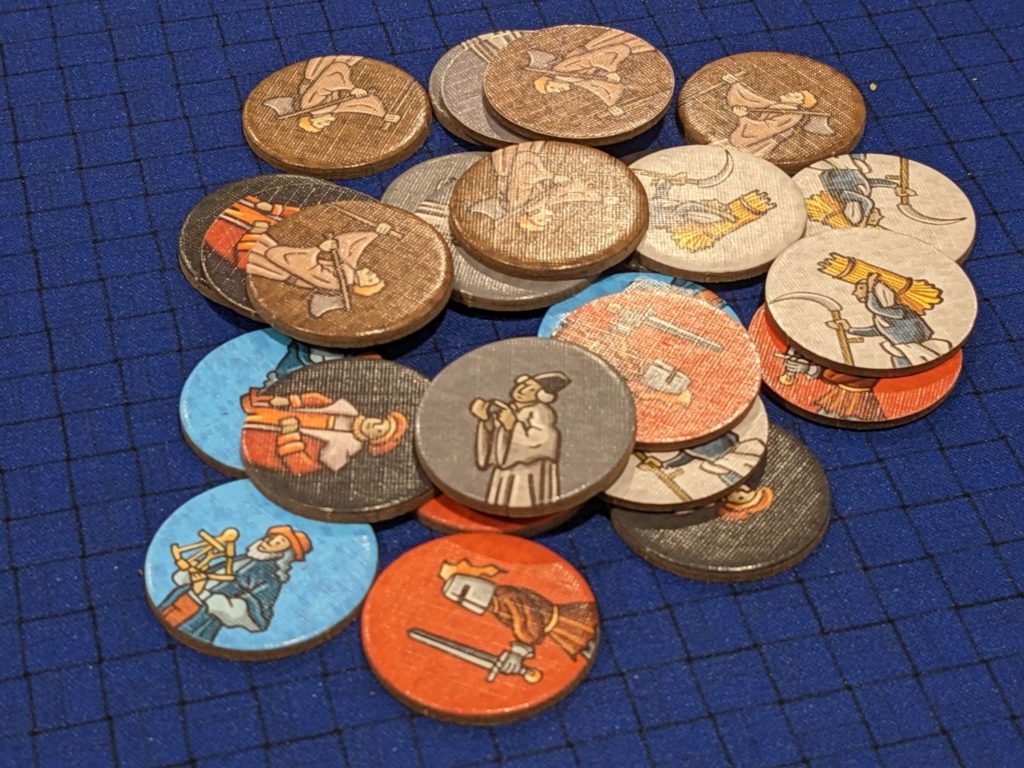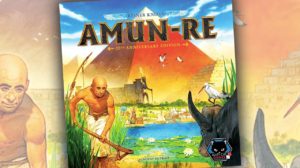Disclosure: Meeple Mountain received a free copy of this product in exchange for an honest, unbiased review. This review is not intended to be an endorsement.
I first played Orléans about six years ago with friends at a game night in Chicago. Even though I got absolutely destroyed in that first play, I wasn’t that concerned with what was happening around me. I loved the 18-round, bag building system that stood out from other popular worker placement games released a few years earlier. (Orléans was originally released in 2014.)
You had tracks, resources that scaled in value, and a map that let players run around to grab stuff while racing to build trading houses before competitors could reach certain spots. I don’t usually like event decks, but the way Orléans handled events was very simple: each round’s rules are altered only slightly by one of six different options, but all players know all of the options before play begins.
With three players, Orléans plays in about an hour, and the ramp up from the initial rounds through the buffet of actions players can take by the end is something else. Add in locations that provide players with varying actions and a couple of different ways to win, and you have a classic that remains on BGG’s top 50 games of all time, almost ten years after its release.
When Joan of Arc: Orléans Draw & Write (2023, Capstone Games) was first announced, I approached the news with a healthy sense of skepticism. Most of the classic games receiving a roll-and-write/flip-and-write treatment usually make me want to break out the original instead of playing the newer, shorter, often shinier version. But I love Orléans, so I had to know: did the designers (including the designer of the base game, Reiner Stockhausen) nail this update?

Draw & Write Lookalike
The best thing about Joan of Arc is the look: on a standard A4 / 8.5” x 11” sheet of paper, the game features everything you need to play AND it looks almost like a miniature version of the original game. The map that is used by each player’s Merchant in the base game to traverse roads and waterways to pick up goods and build trading posts takes up the right side of the player sheet, and the development track still lives at the bottom of the play area.
Kudos to the designers for not changing the general drab look and feel of the original board. Even the goods area feels like the one in the base game. In an additional stroke of layout genius, there are 20 buildings pre-printed on the player sheet. Like trading posts, space is limited; for locations, Joan of Arc requires players to call out a location when it is built so that no one else can use it from their sheet.
There’s a nice economy here in the use of space, and that extends to the gameplay. The efficiency of bag building in the base game is further streamlined: in a round, one player draws a number of tokens from the bag, plus one (so that the first player in a round will be left with an additional action choice). These tokens are the same six “followers” (farmers, boatsmen, craftsmen, traders, scholars and knights) from the base game. On their turn, a player simply selects one follower to take its action.
Farmers still collect goods, but now they are just crossed off on a warehouse grid. Boatsmen and knights still move an imaginary Merchant around the map, but in Joan of Arc, this has been changed. Now, all that is needed is to scribble off a road/waterway taken, then the player scoops up everything on their way to the next trading post. Scholars still advance the development track.

Traders still grant players access to “Place” tiles, now in the form of Locations. These are the 20 building locations that are printed on each sheet; players looking for more variety can use the included location cards instead, which include the original 20 locations plus an extra ten to spice things up a bit.
From there, Joan of Arc turns into the normal trigger-happy buffet of a standard roll-and-write. Fill in a complete column of goods to gain four steps on the development track, or a couple of coins and an extra good, or the like. But that chain begins with the simple act of drawing a follower from a bag, just like the base game.
Once the follower bag has been emptied once per player (so, four times, in a four-player game), play ends and scores are tallied. Much like the base game, your main scoring mechanic might come from either a large collection of goods or a fair amount of trading posts and citizens multiplied by the development track value. Other scoring options abound, be it bonus scoring by completing certain rows/columns in the money and warehouse areas, or by not using the optional collection of monks that can modify a follower’s action.

Here’s the Catch
Joan of Arc is a fun time. It’s certainly quick, and it provides an experience that reminds this olden-time Orléans fan about how much I enjoy the base game. The look and feel of Orléans is here, and even though I think the base game is easy to teach to a gamer, Joan of Arc wins out as a game to teach anyone, hobby gamer or not.
But at a play time of about an hour with four players, Joan of Arc left one of my game groups saying what I was thinking: couldn’t we just play the base game? With four experienced players, Orléans can be wrapped up in about 75 minutes and provides a much richer experience with a decent physical production.
That’s the breakpoint for me. Joan of Arc and Orléans are two distinct gaming experiences; I don’t think I would need to own both. (I own Orléans plus all of the expansions from its initial print run by Tasty Minstrel Games.)
Joan of Arc is a fantastic long filler that provides a good chunk of the core Orléans experience at a price under $30. Joan of Arc also shines in one other area: solo play. The base game’s solo experience was only made available through expansion content, and even then, it’s not ideal. Joan of Arc fixes that with a 20-minute experience against an AI that is incredibly easy to administer, while also providing a pretty stiff challenge. The amount of followers that are played are the same as a two-player game, and the solo AI deck is a cinch to whip out and plow through. I did two separate two-game solo sessions, and the second one only took me half an hour to play two full games. It’s a great teaching tool as well, so definitely give the solo a spin before teaching the game to other players.
For long-time fans of Orléans: I think you’ll enjoy a couple plays of Joan of Arc, then gravitate back to the base game. Each time I finish playing Joan of Arc, I want to whip out the base game. Even without the expansions (and yes, I know some people believe that the base game plus Orléans: Trade & Intrigue is the only way to play), Orléans remains a Euro design classic and it is an incredible foundational experience for people looking to really invest in the hobby.
Joan of Arc, though? Solid.












Add Comment